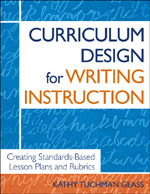Curriculum Design for Writing Instruction
Creating Standards-Based Lesson Plans and Rubrics
- Kathy Tuchman Glass - Glass Educational Consulting
Foreword by Carol Ann Tomlinson
"The author's conversational style hooks and easily engages readers into the four-step curriculum design process, well-sequenced array of design templates and lesson models, synthesis of the six traits and writing process elements, and integration of history, social science, and science content."
Carl Zon, Standards and Assessment Consultant/Coach
Connections, Sunnyvale, CA
"This book effectively walks educators through the standards-based lesson design process in a way that is clear, compelling, and achievable while simultaneously building content knowledge and extending understanding."
Ruth Goldhammer, Coordinator, Curriculum and Staff Development
San Mateo County Office of Education, CA
Design innovative and engaging lessons and units that produce measurable gains!
This clever new resource takes the reader step-by-step through the curriculum design process: from identifying national and local standards and translating them into user-friendly language to crafting meaningful writing assignments and assessments that effectively reveal student strengths and weaknesses.
Rooted in the six-traits model of instruction and assessment and illuminated by relevant classroom examples, Glass's four-part process shows teachers how to:
- Identify grade-level content standards for writing
- Create a teacher rubric with a clear set of criteria for writing assessment
- Craft a student checklist that guides students through the unit and prepares them for teacher expectations
- Design lessons that help students achieve success
Replete with tools, strategies, examples and reproducibles, Curriculum Design for Writing Instruction is a valuable resource for any teacher who wants to boost student achievement in writing for any subject and for any grade level!
The author’s conversational style hooks and easily engages readers into the four-step curriculum design process, well sequenced array of design templates and lesson models, synthesis of the six traits and writing process elements, and integration of history, social science, and science content.
This book effectively walks educators through the standards-based lesson design process in a way that is clear, compelling, and achievable while simultaneously building content knowledge and extending understanding.

